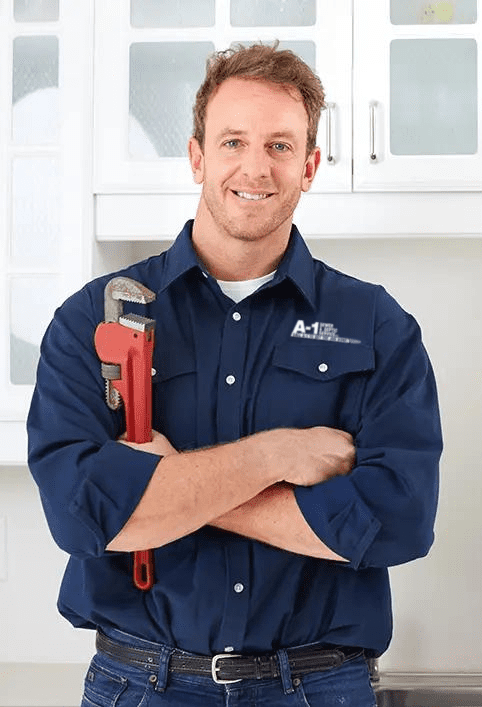While it is important to have your water heater inspected by a professional on an annual basis, you can take steps throughout the year to personally ensure that everything is running well and your hot water is there when you need it!
Types of water heater maintenance:
- Water heater repair
- Water heater cleaning
- Water heater insulating
- Water heater replacement
All of these DIY maintenance tips can help make your hot water heater run at peak performance, help with energy efficiency, prevent clogs, and sediment buildup and ultimately extend the lifespan of your water heating system.
Water Heater Repair
Water heater repair can range from a new anode rod to heating elements, valves, or other parts of the water heater system. How you fix a water heater will depend on the issues at hand.
One of the primary things to do is look out for problems with pressure. Whether you have a gas water heater or an electric water heater, you’ll need to pay attention to the pressure in the tank (this will not be the same for those with a tankless hot water heater. The average boiler should read a pressure of 12 to 15 pounds. If the pressure goes beyond 30 pounds, this could result in damage and even pose a danger. You will probably find the pressure reading on the same gauge where you can find the temperature and altitude as well (altitude refers to how high the water level is). Also, there is a pressure-relief valve on top of the water heater (also referred to as a t&p valve as well as a TPR valve – temperature and pressure relief valve). Should you ever notice that water is seeping out of this valve on the side of the water heater tank, this indicates that the boiler’s pressure is at 30 pounds. Call for professional help as soon as possible.
Fortunately, if you regularly check the water pressure, this might be the only thing you need to do for maintenance. If you do encounter a problem with your water heater, it is usually advisable to leave the solution to a professional. However, if you discover that your boiler’s pressure is way too high, you may be able to solve the problem by draining the expansion tank. This tank (a cylinder with a drain valve) will be somewhere above the boiler.
A hot water heater can also be drained, known as a hot water heater flush, so you can get the sediment buildup out from the bottom of the tank. Typically you will shut off power to the tank, which will turn off the heating element (WARNING – allow time for the water to cool, as the water inside of the tank is scalding hot, and the water temperature is enough to cause SERIOUS INJURY – if you have ANY doubts about your ability, please call a professional plumber). Once the water temperature is cool enough, you can put a garden hose on the drain valve, open the valve, and thus funnel the water out of the tank for as long as it takes to get the boiler pressure to be the same as the expansion tank pressure. Once you’ve drained the water, you will refill it with cold water from the cold water supply water lines running to the top of the tank. Before filling, open the shutoff valve and let the water run on the hot water side of your faucets – this will help purge air from the system
If you need to drain the expansion tank, you will have to turn off the power and cut off the water flow going to the water heater. Then you will need to wait for the tank to cool down.
Not everyone has this type of expansion tank though. Some people have diaphragm expansion tanks. In this case, when boiler pressure is too high, there is an issue with air pressure, not water volume. You can take a tire pressure gauge to find out the air pressure in the expansion tank. Compare the air pressure on the gauge to the recommended psi (pounds per square inch) that is listed on the tank. Then you only need a bike pump to get the air pressure to the right levels.
Don’t know which type of expansion tank you have? You can call your building department or public utilities to find out. Once you have done what you can for your expansion tank, keep an eye on the hot water system to make sure that everything is okay when it reboots. If the pressure on your boiler still spikes up, then you need to call an experienced plumber to diagnose the problem.
If you’re experiencing colder water temperatures, but can see the burners are firing, it’s possible that your dip tube has cracked or broken. The dip tube is a water pipe that carries the cold water supply to the bottom of the tank to be heated, allowing the hottest water to be at the top. Replacing this dip tube can relieve these issues.
Water Heater Cleaning
As hot water tanks go throughout the lifespan, performing a cleaning can help extend the unit’s shelf life. Sediment can collect in the bottom of the tank, and if you have hard water this sediment buildup and the need to drain your tank will occur more frequently. This is where an anode rod, which is made of magnesium or aluminum, can come into play in order to keep the tank clean and functioning correctly. The anode rod is there to prevent corrosion inside of the tank and try to prevent you from needing a new water heater! A properly working anode rod will eventually wear down to practically nothing. If you look at your anode rod and it’s either a ½” long or shorter, or is covered in calcium deposits (calcium will look like a white, hard substance covering the rod) then it is time to replace the anode rod.
There are other parts of your water heater that may need to be cleaned over time, including the pilot light area, should debris or a spider’s nest find its way there. The pilot light is there to keep a small flame burning that heats the thermocouple – that thermocouple is there to only allow gas to flow if there is enough heat to warm the metal and expand to allow gas to flow, so when the thermostat calls for hotter water, the heating element kicks on at the bottom of the tank and keeps the 40 or 50 gallons of water at the correct water temperature.
If the pilot is working, and everything is in good shape, replacing the thermocouple can get your water hot again.
Water Heater Insulating
One of the ways to improve your water heater’s performance and energy efficiency is by insulating the water lines (or water pipes) that carry the heated water to your home’s faucets, showers and tubs. You can also insulate the tank and expansion tank (realize that these tanks are insulated from the factory, but additional insulation can help keep more heat from escaping)
There are a plethora of DIY kits available from online and local retailers that can be cut to fit your particular application and help with insulating your hot water heater.
Water Heater Replacement
If you’ve decided it’s time to replace your old water heater (either because you want to upgrade or it has reached the end of its lifespan), then you have a few options to consider.
Tankless water heaters come in both gas and electric water heater varieties and offer nearly endless hot water!
Going with the traditional style will require more water heater maintenance than the tankless options, but both still need to have some water heater maintenance done to run at optimal levels. Deciding between a tankless and traditional hot water heater can be a challenge that our plumbing experts can help you with – just call today!
When you come across a plumbing emergency, day or night, you can find the service that you deserve at A-1 Sewer & Septic Service Inc. Our plumbers provide fast and friendly service to homeowners and businesses throughout Kansas City, and can handle emergencies that occur after business hours. Call our team of experienced technicians today to get a quote. No problem is too big or too small for us to handle.



